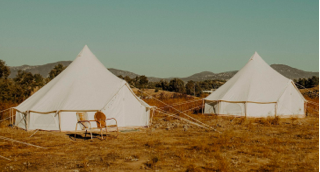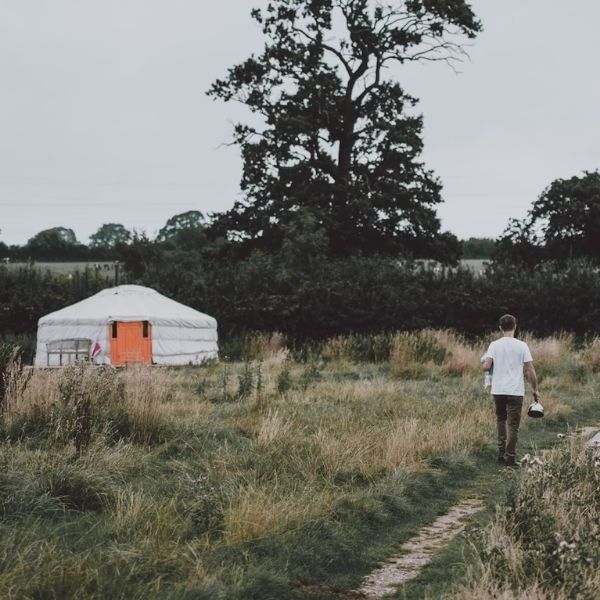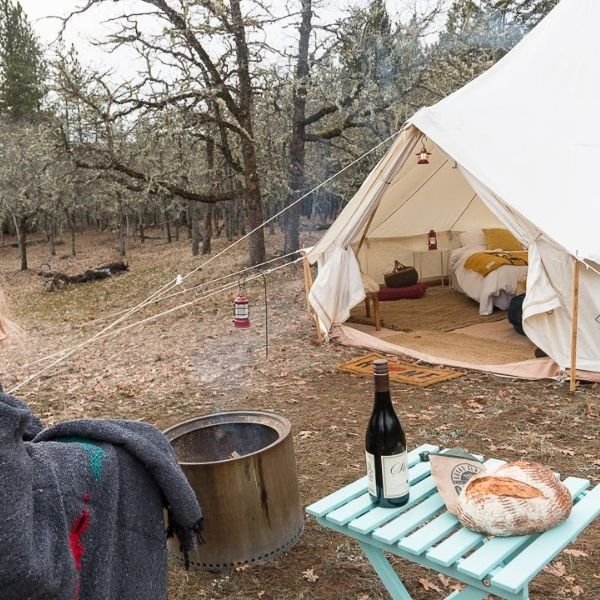PAY NO SALES TAX
Questions? CALL 971-220-8368
Free Shipping

Pay No Sales Tax
30-Month Warranty
PAY NO SALES TAX
Questions? CALL 971-220-8368
Tents
Shop


The LiT List
Glamping & Camping Ideas + Resources
Pros and Cons of Canvas Wall Tents - Which is Best for You?
8 min read
When it comes to camping, there are a lot of different options to choose from. One popular choice throughout history is the canvas wall tent, but what are they? What are the pros and cons, and which one should you choose for your next camping trip?
In this article, we will answer all of those questions and more. We'll start by discussing what a canvas wall tent is and what it's used for. Then we'll talk about the pros and cons of using wall tents for canvas tent camping. Finally, we'll help you determine which type of canvas tent is best for you.

Source: TinyHouseBlog.com
What Are Canvas Wall Tents?
Unlike most tents and teepees, a canvas wall tent has sturdy upright walls like a house. These walls provide a bigger barrier between the canvas tent's interior and the elements, and their rigid angles give canvas wall tents a rectangular layout rather than a standard circular layout. Their pitched roofs help create ample space; often tall enough for the average person to stand up fully upright inside from wall to wall.
Canvas wall tents come in a variety of sizes and dimensions, but they are generally taller, larger, and bulkier than most tents. Their lofty interior spaces and cabin-like shape along with flooring or platform foundations make it possible to fit multiple large pieces of furniture such as raised beds, wood stoves, and more within them. All-in-all, camping in a canvas wall tent can feel surprisingly close to home, especially if you're accustomed to common nylon camping tents.
More than a Mere Tent to Victorian Outfitters

Source: Shelly Peters on Pinterest
Their appearance may evoke the image of explorers and hunters trekking through the Safari in centuries past, and this is not a coincidence. In fact, canvas wall tents were so widely used by outfitters in the Victorian era that many still refer to them as 'safari tents' and 'outfitter tents' today.
Wall tents were much more then tents to outfitters and frontiersmen, however - they were home. They provided the means to be connected with and protected from natural forces in a uniquely important way. Beyond the safari, this ability allowed wall tents to serve as impromptu doctor's offices, meeting rooms, trading posts, poker halls, and more.
Nearly all boomtowns in the US were dotted with wall tents as adventurous folks rushed in. They were a reliable option for families seeking a functional long-nofollow term living space while settling into undeveloped land:

Source: Pacific Grove Museum of Natural History
Wall tents fulfilled this need so well that many of these families began construction by framing their outfitter tent with wood planks and simply building their new home around it. To this day, a trained eye can find the eerily familiar shape of a canvas wall tent greeting them at the front door of victorian era homes across the western united states.

Source: Sanctuary Vacation Rentals
What are canvas wall tents used for today?
-
Outfitter Tents for Hunting

Source: Mohammed on Unsplash
Canvas wall tents are popular among hunters for many of the same reasons outdoorsmen cherished them in the past. They provide hunters with a large, enclosed space that can help meet their multiple needs for storage, shelter, and security.
The canvas walls and flooring of outfitter tents are much thicker than those of standard camping tents, which makes them better able to withstand the harsh weather conditions often found in prime hunting locations. A fly tarp or woodstove as an accessory can offer even further protection and comfort from the safari to the mountain snow, and this versatility makes them a worthwhile long-term addition to the base camps of many hunters around the world.
-
Glamping

Source: Lucija Ros on Unsplash
Glamping is the idea of enjoying the comforts of home while camping in nature - from a king-sized bed to a hot shower. For those who want to glamp in style, canvas wall tents offer a luxurious solution. They provide all the space and often the amenities of home while maintaining a rustic feel that helps you appreciate your natural surroundings.
Many glamping resorts will use canvas wall tents as individual units or group them together to create a 'tent city'. When set up in this way, they offer a balance of privacy and social interaction for guests.
-
(Semi) permanent dwellings & full-time living quarters

As we've seen, canvas wall tents were once the primary form of shelter for many settlers in the west. Today, they are still used as permanent or semi-permanent dwellings by many people who choose to live off the grid or in remote locations.
For those who want to experience a more traditional way of life, canvas wall tents can provide all the necessary space for full-time living quarters. This includes a kitchen, bedroom, and living room area - nearly everything you need to live comfortably in nature.
Canvas Wall Tent Pros & Cons

Source: Dipanwita Chanda on Unsplash
Now that we've seen some of the ways canvas wall tents are used today, let's take a look at some of the pros and cons to help you decide if one is right for you.
PROS of a Wall Tent:
- They're spacious. Wall tents offer much more space than standard camping tents, which makes them ideal for long-term setup and habitation.
- They're durable. The thicker walls and flooring of a canvas wall tent can withstand harsher weather conditions and wear and tear, making them a good investment for those who plan on using them in harsh conditions or over a long period of time.
- They offer privacy. The larger lofty space and thicker walls make canvas wall tents ideal for those who want a little more privacy while glamping or camping. This is especially true in settings like large campgrounds, where the ability to stand and walk around within the tent offers a separate space from the public for changing clothes or simply relaxing.
- They can be used as semi-permanent or permanent dwellings. For those who want to live off the grid or in remote locations, canvas wall tents offer a viable solution for full-time living without the need to construct a legitimate building. This helps avoid permit and construction costs in many instances.
CONS of a Wall Tent:
- They're expensive. Canvas wall tents are typically more expensive than standard camping tents, which can make them a prohibitive option for those on a tight budget.
- They're heavy and difficult to transport. The larger size and heavier materials of canvas wall tents make them difficult to transport, especially if you're planning on backpacking or hiking into your camps. The vast majority of outfitter tents cannot be reasonably transported long distances by a single person.
- They're difficult to set up. The larger size and weight of canvas wall tents make them more difficult to set up than a standard camping tent, which can be a problem if you're planning on setting up camp in a hurry or in bad weather conditions.
All-in-all, Safari tents have their place in the world of large canvas tents, but there is a reason their popularity among regular campers and tent owners faded into more specific niches like glamping resorts, tent cities, and hunting. The durability and close-to-home feeling they provide comes at a massive convenience cost and steep learning curve in regards to their setup, transport and maintenance.
Though they're an excellent option for seasoned outfitters who are not frequently relocating and have the means to transport a large amount of heavy gear, the average camper, glamper or festivalgoer may find the weight, complexity and size not worth the hassle. For most canvas tent camping, its durability and size are simply not necessary.
Canvas Bell Tents vs. Wall Tents: What's the Difference?

Now that we've seen the pros and cons of canvas wall tents, let's take a look at the difference between canvas wall tents and their popular cousin, the canvas bell tent.
The most obvious difference between the two types is in their shape. As you can probably guess from their names, canvas wall tents are rectangular in shape, while canvas bell tents are — you guessed it — shaped like a bell. This gives canvas bell tents a few advantages over their rectangular counterparts.
First, canvas bell tents are more aerodynamic. This means that they’re less likely to collapse in on themselves in harsh weather conditions and require less structural support. Additionally, the simpler design and lighter total weight make them much easier to transport than canvas wall tents. Lastly, they’re more affordable. All of the above factors make canvas bell tents less expensive than canvas wall tents of comparable size.
Canvas Bell Tents

If you're looking for the best of both worlds, a canvas bell tent may help you avoid a steep learning curve. Canvas bell tents are easier to set up than canvas wall tents, but they're also large and durable. They're perfect for those who want the space and durability of a canvas wall tent without the weight and complexity — and at a lower price point.
Canvas bell tents are a sleek compromise between the versatile teepee and the opulent safari tent, providing a more suitable and forgiving option for those seeking their first canvas tent. With glamping and quality outdoor gear on the rise in recent years, it's likely that we'll see more and more people opting for canvas bell tents in the future.
Here are a few things to keep in mind if you're considering a canvas bell tent:
- They're more expensive than standard camping tents but less expensive than canvas wall tents.
- They're larger and heavier than standard camping tents, but not as large or heavy as canvas wall tents.
- They're more hardy and durable than nylon tents, but not as thick as most wall tents.
- They're easier to set up than canvas wall tents, but more difficult to set up than standard camping tents.
Like canvas wall tents, bell tents can come in a variety of options and sizes along with plenty of accessories (including flooring, platforms and wood stoves!). Our selection of canvas bell tents can help you get an idea of the options available to choose from.
How to Choose the Right Tent for Your Needs: Guide for Buying Canvas Tents
Now that we've seen the pros and cons of both canvas wall tents and canvas bell tents, it's time to choose the right tent for your needs. Here are a few things to keep in mind when choosing a canvas tent:
- How often will you be using the tent? If you'll be using the tent on a regular basis, a canvas wall tent is a good option. If you'll only be using the tent occasionally, a canvas bell tent is a better option.
- How many people will be using the tent? Though both tent styles can come in different dimensions, canvas wall tents may be worth considering if you want to accommodate a large group of people because they make bunk beds more practical.
- What is your budget? Canvas wall tents are more expensive than canvas bell tents. If you're on a tighter budget, a canvas bell tent is the way to go. If you find canvas bell tents too expensive, you may want to wait to save or opt for cheaper nylon tents.
- How will you be using the tent? If you'll be using the tent for camping, glamping or festival-going, a canvas bell tent is a good option. If you'll be using the tent for hunting or other long-term outdoor activities, a canvas wall tent may be a better option.
SHOP OUR CANVAS TENTS
Conclusion
Canvas wall tents are a popular option for those looking for a construction-less cabin. They're durable, reliable, and can withstand harsh weather conditions. However, they're also more expensive and heavier than other types of tents. If you're looking for a quality canvas wall tent, be prepared to spend a bit more money and carry a lot more weight.
Canvas bell tents are a great option for those who want the space and durability of a canvas wall tent without the weight and complexity. They're a great alternative to outfitter tents for those who are not accustomed to the setup and transport responsibilities of canvas tents.

Brandy Lamb
Father of two aspiring glampers, husband to one inspirational wife, and Co-Founder of Life inTents. Continuously striving to help make camping more comfortable.
Related Resources

THE LIT LIST 4 min read
What Is a Yurt Tent?
If you want a bohemian backyard retreat or a romantic glamping weekend, a yurt tent could be just whWhat is a yurt shaped tent? Explore how traditional yurts have evolved and learn the different styles of modern yurt tents used for glamping today.

THE LIT LIST 4 min read
How Long Do Glamping Tents Last?
Exactly how long do glamping tents last? Well, it depends. And the answer mainly comes down to qualiHow long do glamping tents last, really? The lifespan of glamping tents depends on their quality. Read on to discover quality features and how to make them last.
Popular Blogs
Camping Gift Ideas for People Who Have Everything
The Best Portable Tent Heaters - Ways To Heat A Canvas Tent
Glamping in Northern California: 8 Luxury Sites
Waterproofing A Canvas Tent - Retreating Canvas
33 Camping Quotes to Inspire Your Next Adventure
What Is Glamping? Origins, Definition, Destinations & More
10 Tips for Staying Warm While Winter Camping
How to Maintain and Clean a Bell Tent
Essential Family Camping Checklist: What to Pack [PRINTABLE]
Backyard Glamping Checklist for an Unforgettable DIY Glampsite
Popular Products
Subscribe
Sign up to get the latest on sales, new releases and tips
BECOME AN INSIDER
We’ll periodically share inspiration, bell tent releases, special offers, and event notifications with ya.


